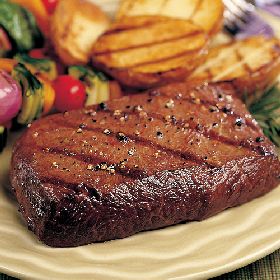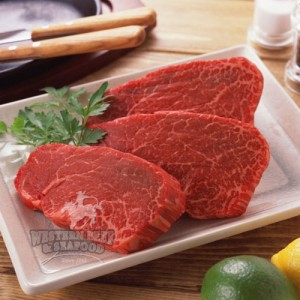
You’re starting to see Flat Iron Steak on more restaurant menus.
In the North American Meat Processor (NAMP) meat buyers guide, it is item #1114D Beef Shoulder, Top Blade Steak. The NAMP lists it as the second most tender cut, after the Tenderloin, and followed (in order) by the Top Sirloin Center-Cut, the Ribeye and Strip Steak Center-Cut, and finally Beef Shoulder, Arm.
 From Derrick Riches’ Guide to Barbecues & Grilling website:
From Derrick Riches’ Guide to Barbecues & Grilling website:
“The Flat Iron Steak (also know as a Top Blade Steak), now appearing in grocery stores and on restaurant menus was developed by teams at the University of Nebraska and the University of Florida. The problem that presented these researchers of the cow was what to do with a waste cut of beef from the shoulder of the cow. Though a flavorful and relatively tender cut of meat, the top blade roast has a serious flaw in the middle of it; an impossibly tough piece of connective tissue running through the middle.
 “So, after developing a method for cutting and presenting this steak, these friendly scientists have presented to us an amazing cut of beef. More than that, they have developed a nearly perfect steak for the grill. The Flat Iron (supposedly named because it looks like an old fashioned metal flat iron) is uniform in thickness and rectangular in shape. The only variation is the cut into the middle of the steak where the connective tissues have been removed.
“So, after developing a method for cutting and presenting this steak, these friendly scientists have presented to us an amazing cut of beef. More than that, they have developed a nearly perfect steak for the grill. The Flat Iron (supposedly named because it looks like an old fashioned metal flat iron) is uniform in thickness and rectangular in shape. The only variation is the cut into the middle of the steak where the connective tissues have been removed.
“Like any non-loin steak, the Flat Iron benefits from marinating and is best if it isn’t cooked too well beyond medium. Depending on the particular cut you pick up you might find it more convenient to cut the Flat Iron steak in half because of the center cut through the middle.
“This steak has a deep, rich flavor which makes it perfect not only on its own, but also as meat for many dishes. The Flat Iron is very similar to any of the Flat Steaks so anything calling for Skirt or Flank Steak will benefit from a Flat Iron Steak. This steak is best grilled over a medium high heat. I don’t suggest going as hot as possible unless you pick up a particularly thin cut. I like to get them thick (about an inch or more) so I grill at a little lower temperature to keep from charring the outside before it heats through the middle.
“If your butcher stares blankly at you when you ask for a Flat Iron steak, it might not be because he’s a bad butcher. It might be that this particular cut (or actually this particular name) hasn’t caught on in your neck of the woods. Instead ask for a Top Blade Steak. But definitely track one down and give it a try. You might just find your perfect steak.”
You can get more information at Derrick’s blog by clicking HERE.
If you have problems seeing the video below click HERE
.youtube::T_ss3vS-iT4::
